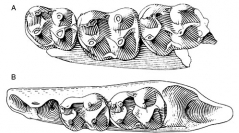

 Geodiversitas
22 (3) - Pages 415-432
Geodiversitas
22 (3) - Pages 415-432Description of an upper jaw of Cuisitherium lyddekeri recovered from the Ypresian locality of Monthelon allows more precise characterization of its dental features as well as the relationships and systematic status of the genus Cuisitherium. Cuisitherium is probably directly ancestral to the monospecific genus Lophiobunodon, recorded to date from late middle Eocene levels (La Livinière, MP15). The relationship Cuisitherium-Lophiobunodon shows that the acquisition of dilambdodont upper molars (with W-shaped ectoloph and centrocrista fold) was realized rapidly during the middle Eocene and did not involve any modification in lower molar morphology. Cuisitherium belongs in to the Choeropotamidae (including Haplobunodontidae) as formerly proposed by Gentry & Hooker (1988).
Mammalia, artiodactyl, Eocene, evolution, systematics